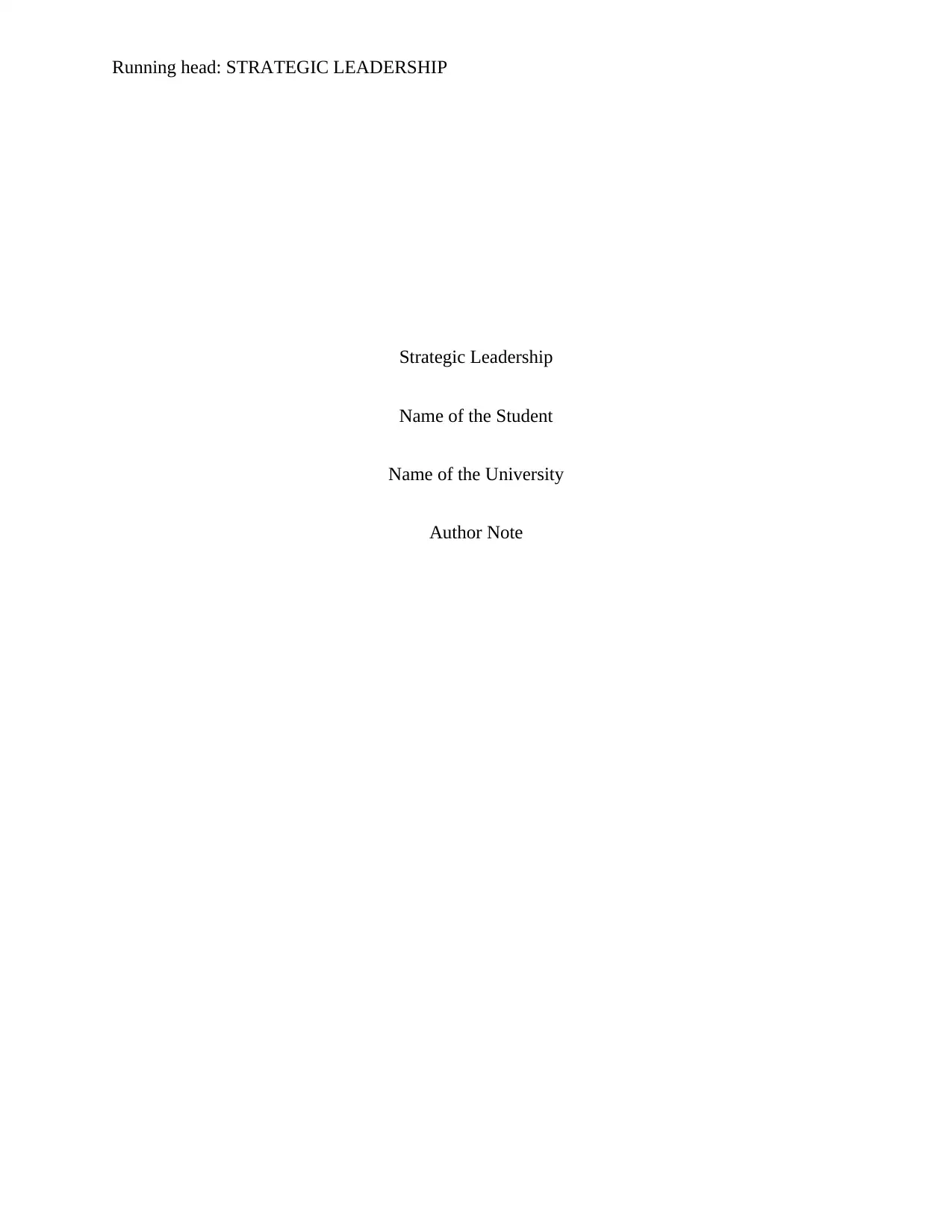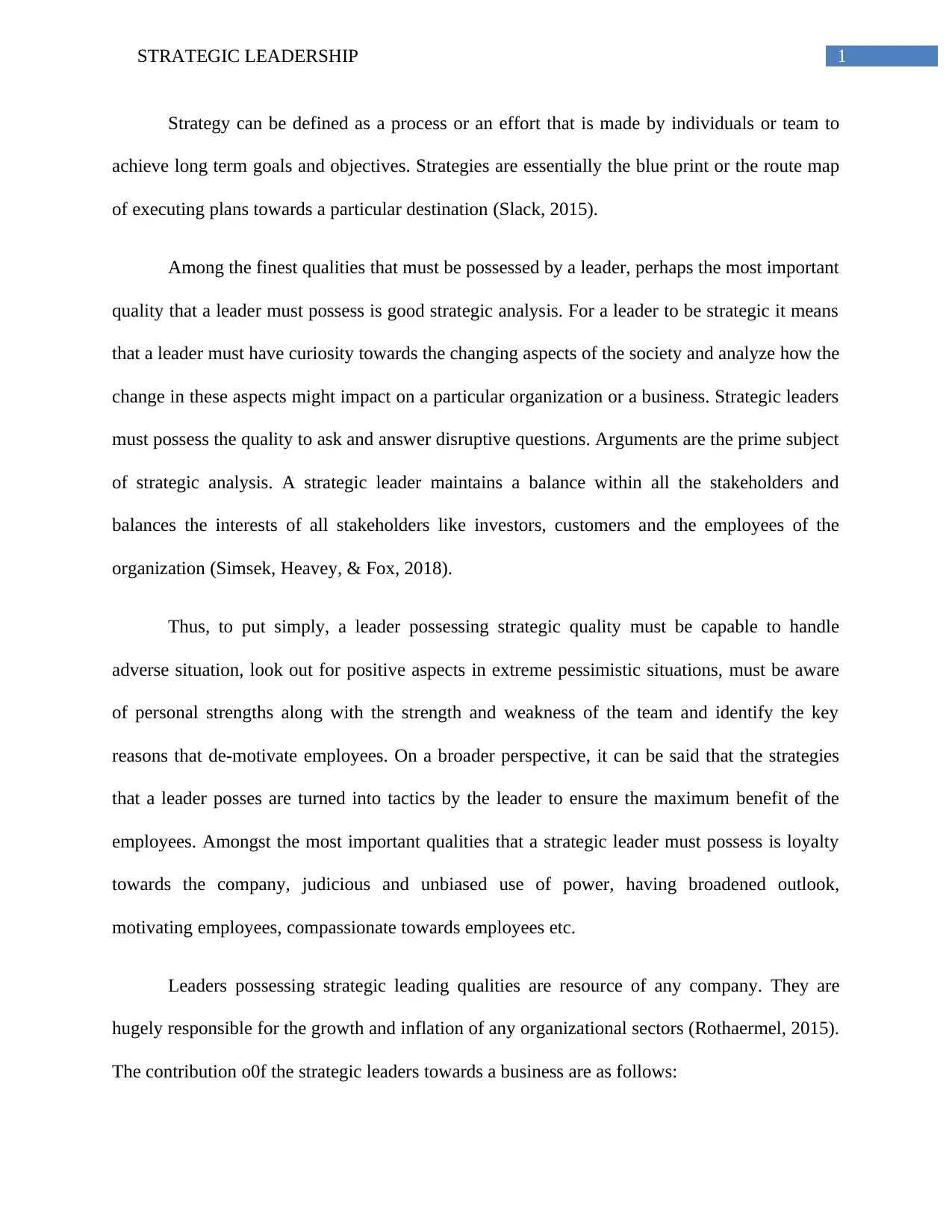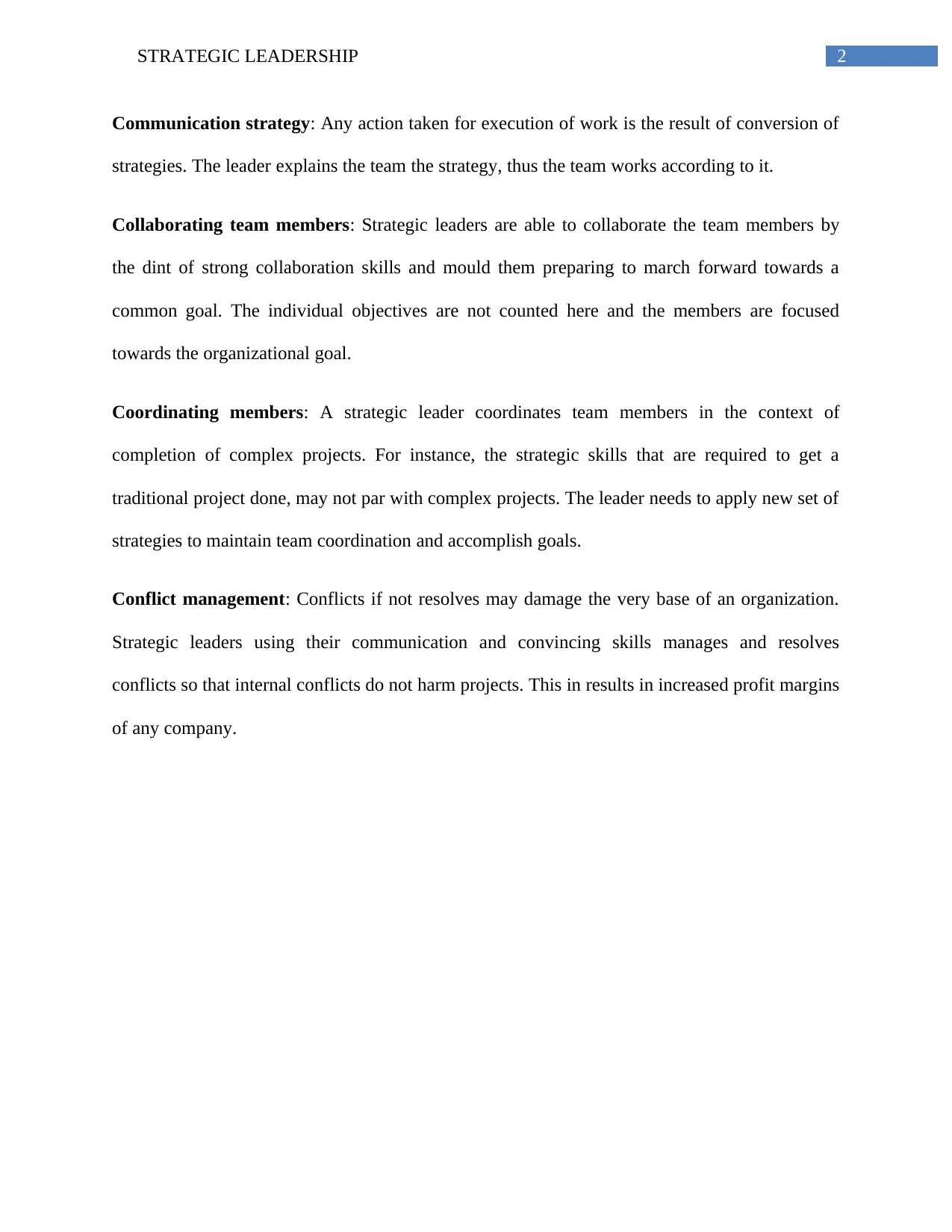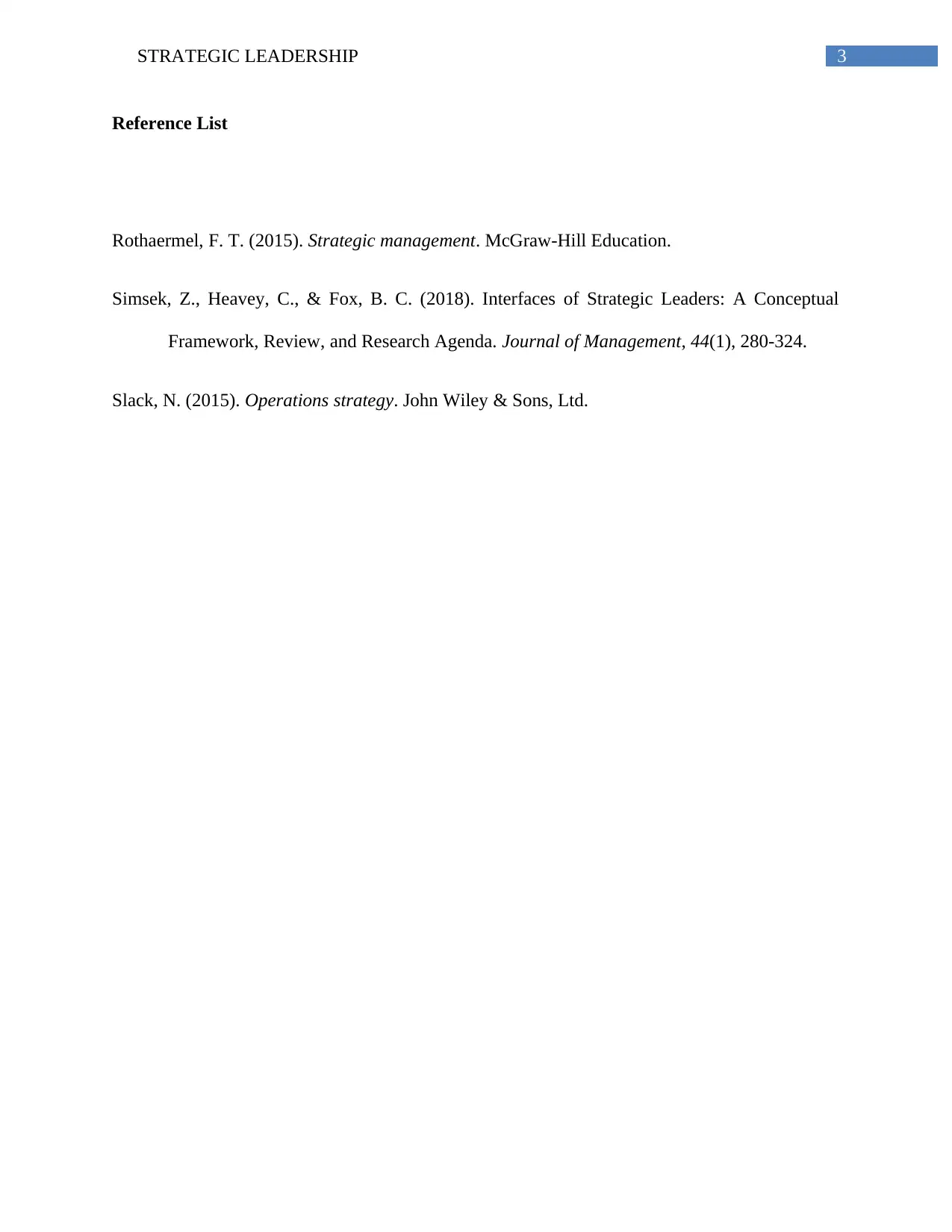Strategic Leadership: Qualities, Contributions & Conflict Resolution
VerifiedAdded on 2023/06/14
|4
|629
|357
Essay
AI Summary
This essay defines strategy as a process for achieving long-term goals and emphasizes the importance of strategic analysis for leaders. It highlights that strategic leaders must be curious, analytical, and capable of balancing stakeholder interests. Key qualities include loyalty, judicious use of power, a broadened outlook, and the ability to motivate employees. The essay outlines the contributions of strategic leaders, such as developing communication strategies, fostering team collaboration and coordination, and effectively managing conflicts to enhance a company's profit margins. Strategic leadership is crucial for organizational growth and success.

Running head: STRATEGIC LEADERSHIP
Strategic Leadership
Name of the Student
Name of the University
Author Note
Strategic Leadership
Name of the Student
Name of the University
Author Note
Paraphrase This Document
Need a fresh take? Get an instant paraphrase of this document with our AI Paraphraser

1STRATEGIC LEADERSHIP
Strategy can be defined as a process or an effort that is made by individuals or team to
achieve long term goals and objectives. Strategies are essentially the blue print or the route map
of executing plans towards a particular destination (Slack, 2015).
Among the finest qualities that must be possessed by a leader, perhaps the most important
quality that a leader must possess is good strategic analysis. For a leader to be strategic it means
that a leader must have curiosity towards the changing aspects of the society and analyze how the
change in these aspects might impact on a particular organization or a business. Strategic leaders
must possess the quality to ask and answer disruptive questions. Arguments are the prime subject
of strategic analysis. A strategic leader maintains a balance within all the stakeholders and
balances the interests of all stakeholders like investors, customers and the employees of the
organization (Simsek, Heavey, & Fox, 2018).
Thus, to put simply, a leader possessing strategic quality must be capable to handle
adverse situation, look out for positive aspects in extreme pessimistic situations, must be aware
of personal strengths along with the strength and weakness of the team and identify the key
reasons that de-motivate employees. On a broader perspective, it can be said that the strategies
that a leader posses are turned into tactics by the leader to ensure the maximum benefit of the
employees. Amongst the most important qualities that a strategic leader must possess is loyalty
towards the company, judicious and unbiased use of power, having broadened outlook,
motivating employees, compassionate towards employees etc.
Leaders possessing strategic leading qualities are resource of any company. They are
hugely responsible for the growth and inflation of any organizational sectors (Rothaermel, 2015).
The contribution o0f the strategic leaders towards a business are as follows:
Strategy can be defined as a process or an effort that is made by individuals or team to
achieve long term goals and objectives. Strategies are essentially the blue print or the route map
of executing plans towards a particular destination (Slack, 2015).
Among the finest qualities that must be possessed by a leader, perhaps the most important
quality that a leader must possess is good strategic analysis. For a leader to be strategic it means
that a leader must have curiosity towards the changing aspects of the society and analyze how the
change in these aspects might impact on a particular organization or a business. Strategic leaders
must possess the quality to ask and answer disruptive questions. Arguments are the prime subject
of strategic analysis. A strategic leader maintains a balance within all the stakeholders and
balances the interests of all stakeholders like investors, customers and the employees of the
organization (Simsek, Heavey, & Fox, 2018).
Thus, to put simply, a leader possessing strategic quality must be capable to handle
adverse situation, look out for positive aspects in extreme pessimistic situations, must be aware
of personal strengths along with the strength and weakness of the team and identify the key
reasons that de-motivate employees. On a broader perspective, it can be said that the strategies
that a leader posses are turned into tactics by the leader to ensure the maximum benefit of the
employees. Amongst the most important qualities that a strategic leader must possess is loyalty
towards the company, judicious and unbiased use of power, having broadened outlook,
motivating employees, compassionate towards employees etc.
Leaders possessing strategic leading qualities are resource of any company. They are
hugely responsible for the growth and inflation of any organizational sectors (Rothaermel, 2015).
The contribution o0f the strategic leaders towards a business are as follows:

2STRATEGIC LEADERSHIP
Communication strategy: Any action taken for execution of work is the result of conversion of
strategies. The leader explains the team the strategy, thus the team works according to it.
Collaborating team members: Strategic leaders are able to collaborate the team members by
the dint of strong collaboration skills and mould them preparing to march forward towards a
common goal. The individual objectives are not counted here and the members are focused
towards the organizational goal.
Coordinating members: A strategic leader coordinates team members in the context of
completion of complex projects. For instance, the strategic skills that are required to get a
traditional project done, may not par with complex projects. The leader needs to apply new set of
strategies to maintain team coordination and accomplish goals.
Conflict management: Conflicts if not resolves may damage the very base of an organization.
Strategic leaders using their communication and convincing skills manages and resolves
conflicts so that internal conflicts do not harm projects. This in results in increased profit margins
of any company.
Communication strategy: Any action taken for execution of work is the result of conversion of
strategies. The leader explains the team the strategy, thus the team works according to it.
Collaborating team members: Strategic leaders are able to collaborate the team members by
the dint of strong collaboration skills and mould them preparing to march forward towards a
common goal. The individual objectives are not counted here and the members are focused
towards the organizational goal.
Coordinating members: A strategic leader coordinates team members in the context of
completion of complex projects. For instance, the strategic skills that are required to get a
traditional project done, may not par with complex projects. The leader needs to apply new set of
strategies to maintain team coordination and accomplish goals.
Conflict management: Conflicts if not resolves may damage the very base of an organization.
Strategic leaders using their communication and convincing skills manages and resolves
conflicts so that internal conflicts do not harm projects. This in results in increased profit margins
of any company.
⊘ This is a preview!⊘
Do you want full access?
Subscribe today to unlock all pages.

Trusted by 1+ million students worldwide

3STRATEGIC LEADERSHIP
Reference List
Rothaermel, F. T. (2015). Strategic management. McGraw-Hill Education.
Simsek, Z., Heavey, C., & Fox, B. C. (2018). Interfaces of Strategic Leaders: A Conceptual
Framework, Review, and Research Agenda. Journal of Management, 44(1), 280-324.
Slack, N. (2015). Operations strategy. John Wiley & Sons, Ltd.
Reference List
Rothaermel, F. T. (2015). Strategic management. McGraw-Hill Education.
Simsek, Z., Heavey, C., & Fox, B. C. (2018). Interfaces of Strategic Leaders: A Conceptual
Framework, Review, and Research Agenda. Journal of Management, 44(1), 280-324.
Slack, N. (2015). Operations strategy. John Wiley & Sons, Ltd.
1 out of 4
Related Documents
Your All-in-One AI-Powered Toolkit for Academic Success.
+13062052269
info@desklib.com
Available 24*7 on WhatsApp / Email
![[object Object]](/_next/static/media/star-bottom.7253800d.svg)
Unlock your academic potential
Copyright © 2020–2025 A2Z Services. All Rights Reserved. Developed and managed by ZUCOL.



